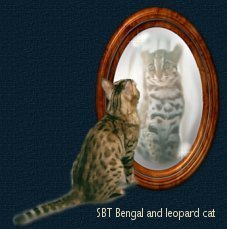|
The Bengal Cat
The Bengal cat makes a loving, intelligent housecat. Curious and entertaining, some even enjoy playing in water and bathing with their owners. They enjoy the companionship of both adults and children and usually adapt to other family pets. Some owners regularly walk their Bengals on leashes. Exercise, nutritional and immunization requirements are the same as for all domestic household cats. The domestic Bengal (four generations or more from the Asian Leopard Cat) has normal litter box habits, is recognized in several cat fancy registries and currently makes up the largest number of cats competing in The International Cat Association (TICA). Also recognized by registries such as AACE, ACF, ACFA, CCA, FIFE, GCCF, NZCF and QICC, this entertaining and affectionate cat is finding its way into more and more living rooms.
Colors and Patterns
The first registry to recognize the Bengal, The International Cat Association (TICA) recognizes several colors (brown, seal lynx point, mink, sepia) and patterns (spotted and marbled) for Championship competition. In the New Breed and Color class, silver, blue and solid black Bengals are accepted for evaluational competition.
Brown Spotted Tabby Bengals
The brown spotted tabby (leopard spotted) Bengals have dark spots on a lighter ground color ranging from gray or tawny to sorrel to golden, very rufused (bright orange) and to a rich mahogony. Note: The Asian Leopard Cat is considered a brown spotted tabby in the cat fancy and ranges somewhat in color.
Brown includes variations of tawny, sorrel, golden, hot rufus and mahogany.
Seal Lynx Point, Sepia and Mink Spotted Tabby Bengals
The seal lynx point (blue-eyed) and seal sepia (gold or green-eyed) spotted tabbies (fondly referred to by breeders as two of the "snow" leopard spotteds) have ivory backgrounds with contrasting spots. The seal mink (aqua or green-eyed) spotted is a combination of one each of the above pointed Siamese and the Burmese sepia genes. Extreme contrast between the markings and the ground color is desirable in each spotted color.
Spotted Seal Mink and Spotted Seal Lynx Point Bengals
Spots of all colors and patterns vary in color, size, rosetting and intensity but preference is given to random and horizontal pattern alignment with wide spacing or "acreage".
Marbled Bengals
The classic tabby gene creates the marbled Bengal and represents a change of pattern from spotted to swirled or marbleized. This dramatic pattern is comprised of swirls of brown spotted colors flowing in a horizontal fashion instead of traditional spots. Preference is given to the more horizontal, flowing and "ocelot-like" patterns. The "marbled" pattern can also occur in lynx, sepia and mink color/patterns (see above).
A Brown Marbled Tabby and a Seal Lynx Point Marbled Tabby
Other Colors & Characteristics
"Glitter," the high shine (usually on a clear, nonticked coat) that has been discovered and developed in the Bengal is a welcome addition to the breed.
"Rosettes," the dark outlining of coat markings (both in the spotted and marbled) that are around a third rich color, are found in many Asian Leopard Cats and other wild cat species. Rosettes showing two distinct colors or shades, such as paw print shaped, arrowhead shaped, doughnut or half-doughnut shaped or clustered are preferred to single spotting but not required.
Some Bengal kittens go through what is referred to as the "fuzzy uglies". A beautifully clear kitten at three weeks old may begin to acquire a ticked kitten coat at four to five weeks old. This coat begins to clear again to higher contrast at about 12 weeks and is again breathtaking by 6 months.
Please Note: There are a variety of other colors (such as blue, black, torbie, etc.) and characteristics (long hair, flat face, etc.) of the Bengal cat which are derived from the domestic genes that DO NOT meet the Bengal standard in TICA... but which may be quite beautiful and shown in UFO and other registries.
Conformation
Bengals are relatively large-boned, shorthaired cats with males averaging from 10 to 15 pounds and females usually smaller. The face should have a distinctly non-domestic expression, with small, rounded ears and intense facial markings. Careful selection ensures Bengal cats that are friendly, loving domestic cats that bear a strong physical resemblance to their Asian Leopard Cat ancestors. Please click on face to read an article about the Bengal's head and face.
Evaluation
Kittens are categorized as to their quality when compared to the accepted TICA Bengal Standard. The Standard for the Bengal cat describes the ideal. Kittens are sold either as pets to be altered, breeders and/or show quality cats. Show quality is the best of the best. Breeder quality is a good cat that has something lovely to offer the breed and no faults or perhaps one or two less desirable traits that can bred out in a generation. Pet quality is a cat that for some reason the breeder feels does not qualify to be offered as a breeder or show cat. This might be due to a visual undesirable trait such as a spot of white color on the throat or groin (referred to as a locket) or a genetic defect that might put offspring at risk for ill health.
Note: Bengal standards as accepted by other cat registries in other countries may vary somewhat.
The International Bengal Cat Society
121 Buhman Road, Washougal, WA 98671

|
|
|

